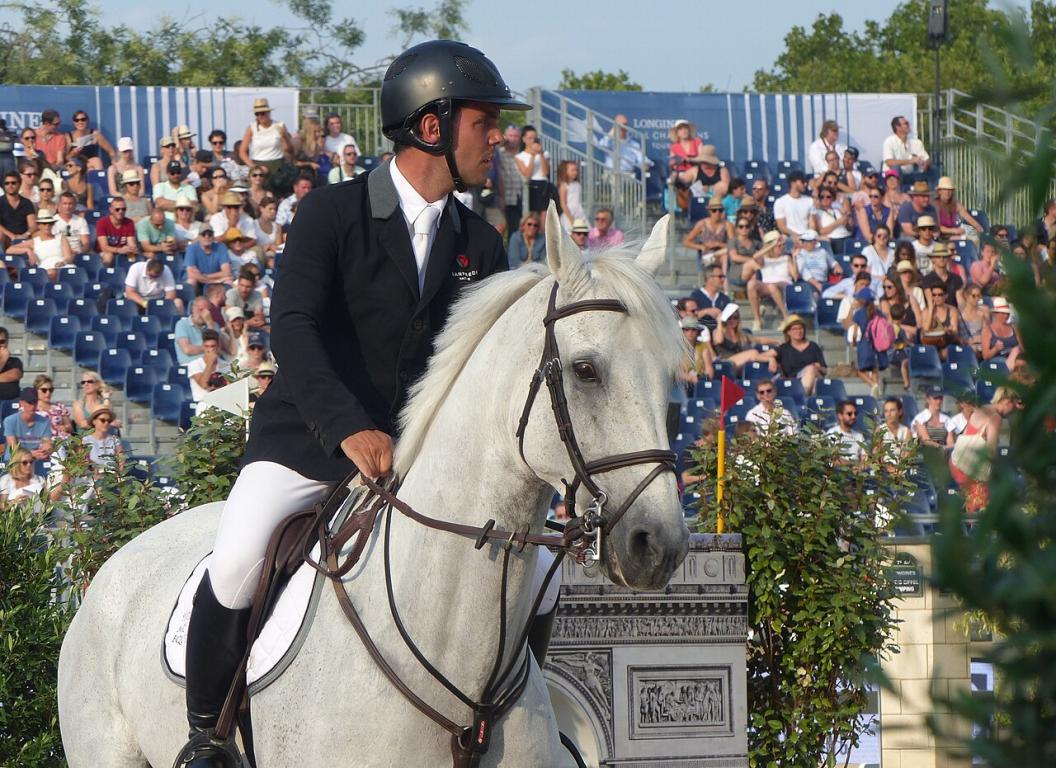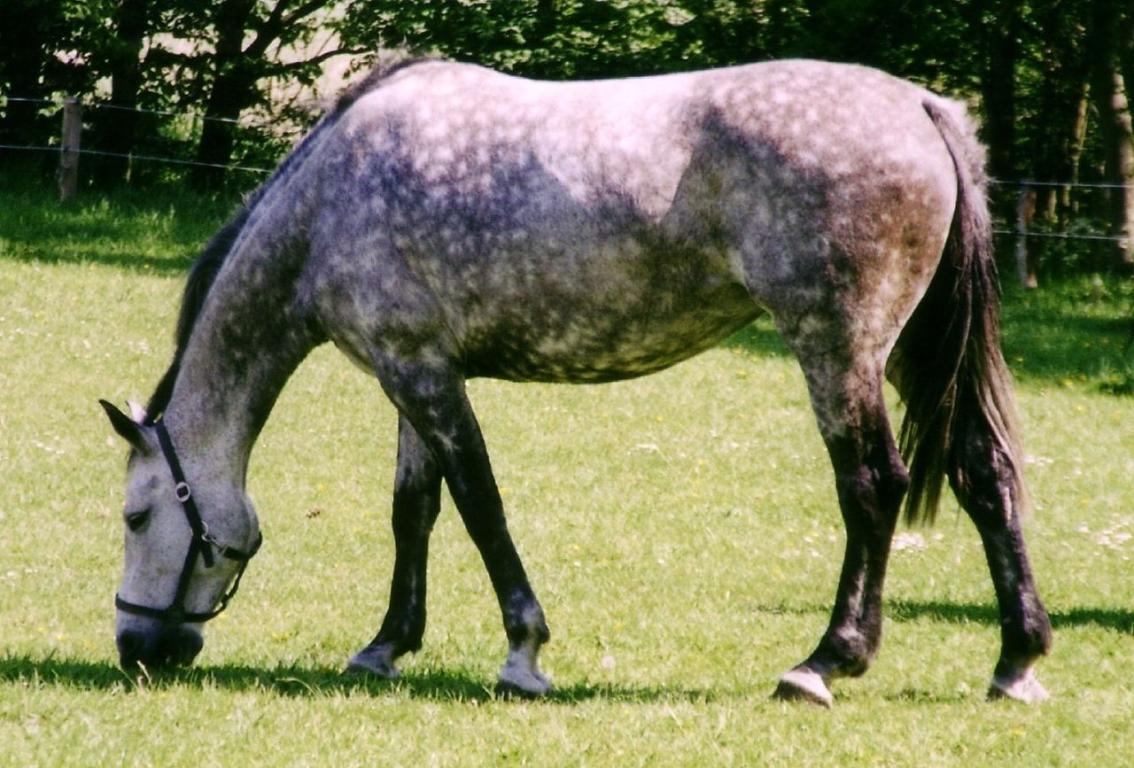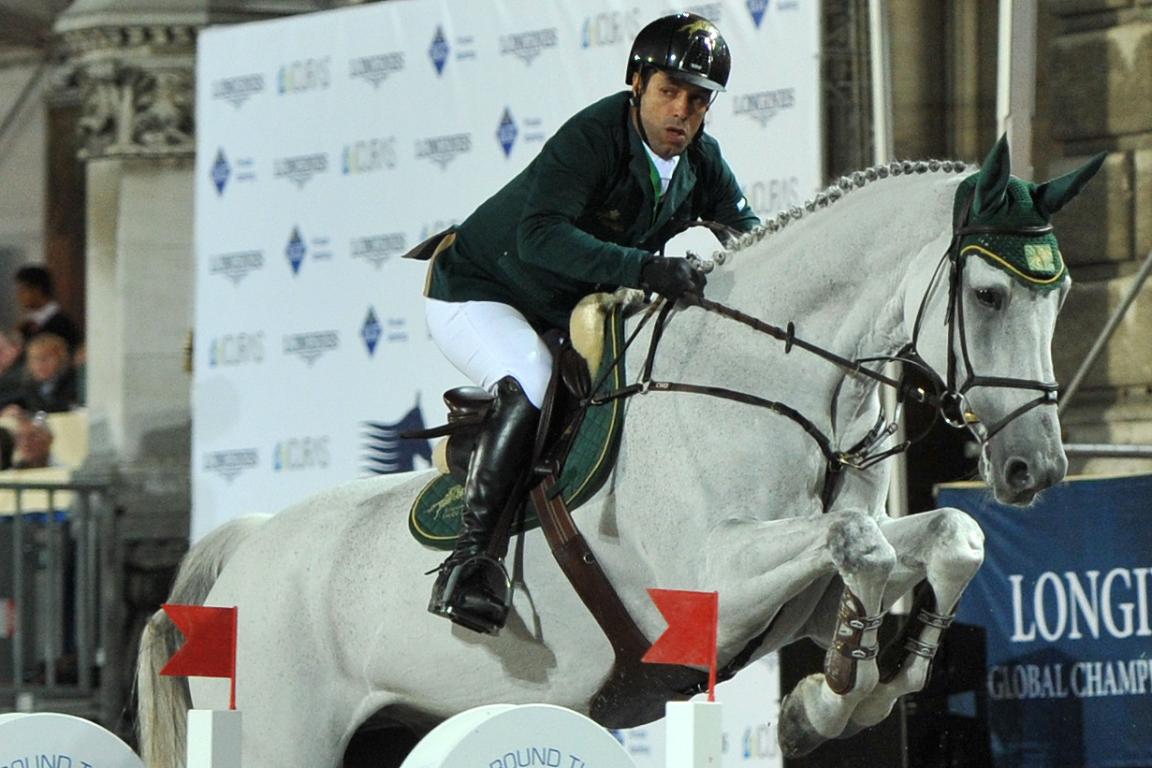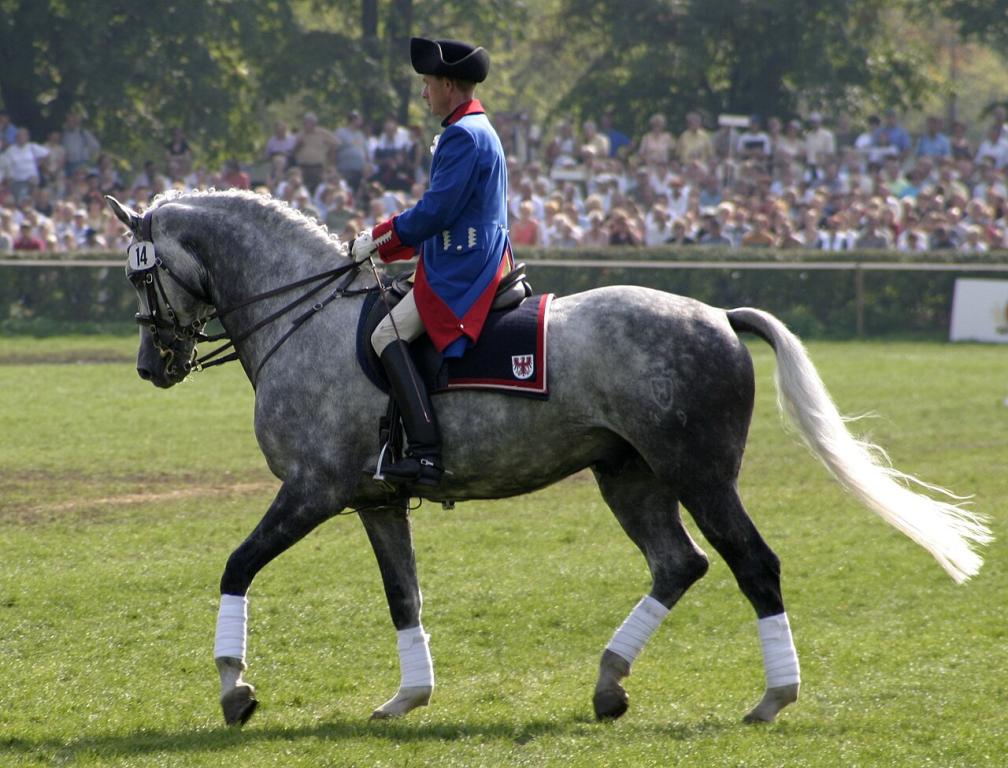
Continent: Europe
Country: Germany
Weight: 550 – 750 kg
Height: 165 – 175 cm



The Holsteiner originates from northern Germany, more precisely from the Schleswig-Holstein region, located between the North Sea and the Baltic Sea. This fertile and outward-looking region has, since the Middle Ages, encouraged trade exchanges and equestrian influences from abroad.
As early as the 14th century, breeders in the region began selecting robust and versatile horses, initially used for warfare, agricultural work, and later for prestigious carriage driving. These horses were crossed with oriental bloodlines (notably Barb and Spanish horses) to refine their type.
In the 19th century, as needs evolved, breeding began to take on a more sporting direction. The year 1883 marked the creation of the Holsteiner
Verband, a studbook that would become one of the oldest and most rigorous in the world. Later, the infusion of Thoroughbred, Selle Français, and Trakehner bloodlines transformed the Holsteiner into a true modern sport horse, renowned for its powerful jump and remarkably steady temperament. Today, the Holsteiner stands as one of the cornerstones of international show jumping, exported worldwide, while maintaining a strong cultural identity in its region of origin.
The historical cradle of the Holsteiner breed lies in Schleswig-Holstein, in northern Germany, between Hamburg and the Baltic Sea. This region, with its fertile pastures, temperate climate, and rich soils, provides ideal conditions for breeding strong, resilient, and well-developed horses.
The most renowned breeding operations are concentrated around the towns of Elmshorn, Neumünster, Kiel, and Itzehoe, where the official studbook inspections are also held. The Holsteiner Verband regularly organizes stallion approvals, elite auctions, and genetic selection events, attracting breeders and buyers from all over the world.
Beyond its German homeland, the Holsteiner is now bred internationally, particularly in:
-France (especially in stud farms focused on show jumping),
-The Netherlands,
-Belgium,
-United States,
-Canada,
-South America,
-Australia.
These breeding zones outside of Germany often rely on imported Holsteiner stallions or semen from leading bloodlines, in order to reproduce high-performance horses locally while preserving the standards of the breed.
The Holsteiner plays a major role in the genetic improvement of modern sport horses, especially in the field of show jumping. Thanks to over a century of rigorous selection led by the Holsteiner Verband, the breed has become an international benchmark for its athletic ability, consistency, cooperative temperament, and sporting longevity.
Several Holsteiner stallion lines, such as those of Capitol I, Corrado I, Carthago, and Cassini I, have become pillars of global breeding, passing on their genetic legacy to many other breeds (KWPN, Selle Français, BWP, etc.).
The Holsteiner is also known for its reliable transmission of sporting qualities: strong hindquarter propulsion, excellent jumping technique, wide range of movement, and outstanding trainability. As a result, it helps improve performance, rideability, and mental balance in Olympic disciplines.
In short, the Holsteiner holds a central position in international breeding programs, both for producing elite-level horses and for stabilizing desirable traits in modern sport horse breeding.
The Holsteiner is one of the oldest and most influential horse breeds in Europe. Its history dates back to the 14th century, in the Schleswig-Holstein region of northern Germany, where it was initially bred to meet military and agricultural needs.
Originally, the Holsteiner was a heavy and powerful horse, used both as a war horse and as an elegant carriage horse for the nobility. Over the centuries, it benefited from oriental blood infusions—notably Barb, Spanish, and Neapolitan horses—that refined its type without compromising strength.
The 19th century marked a major turning point with the official founding of the Holsteiner Verband studbook in 1883, which formalized selection and professionalized breeding. At that time, the Holsteiner began to be used for sport and civilian driving, and gradually evolved into a riding horse, thanks to the influence of Thoroughbreds, and later, Selle Français and Trakehner bloodlines.
From the 1950s to the 1970s, as Olympic equestrian sports rose in popularity, the breed was increasingly oriented toward performance: its conformation became more refined, its temperament more supple, and its natural jumping ability was systematically emphasized. The Holsteiner quickly became a key figure on the international circuit, dominating show jumping podiums and also gaining recognition in dressage and eventing.
Today, the Holsteiner is considered a breed of excellence, with bloodlines such as Capitol I, Carthago, Corrado I, and Cassini I having left a lasting mark on equestrian sport history.
The Holsteiner is renowned for its balanced temperament, willingness to cooperate, and intelligence in work. Selected over generations not only for its sporting ability but also for its mental reliability, the breed shows a character that is calm, composed, yet responsive when needed—qualities highly valued by demanding riders.
It is generally:
-docile and respectful, easy to handle both on the ground and under saddle,
-attentive and focused, especially during technical work sessions,
-brave and honest, particularly in front of obstacles,
-naturally motivated to jump, with a well-developed sense of the fence.
Although it may show some sensitivity—especially in overly stressful environments or under a harsh rider’s hand—it remains overall a reliable, consistent, and loyal horse, with a strong capacity for learning.
This well-balanced temperament makes the Holsteiner an ideal partner for high-level professionals as well as experienced amateurs, particularly in demanding sporting disciplines.
The Holsteiner continues to hold a leading position in global sport horse breeding, thanks in particular to its excellence in show jumping. The breed’s future lies in maintaining this high standard, with an increasing focus on improving temperament, sporting longevity, and disciplinary versatility.
Breeders today aim to produce horses that are:
-easier to ride, including by amateur or semi-professional riders,
-equipped with a reliable mind and balanced temperament,
-showing improved movement to meet the demands of modern dressage.
As international competition becomes more technical and selective, the Holsteiner is evolving toward a model that is powerful, supple, and rideable, without sacrificing the athletic qualities that built its reputation.
Moreover, the digitalization of genetic data, automated performance testing, and computer-assisted selection programs (such as performance indexes) are helping refine breeding decisions and better anticipate inherited traits.
Finally, the global influence of the Holsteiner studbook continues to grow, with a stronger presence in North America, Asia, and emerging equestrian nations, ensuring the breed’s sustainability and genetic impact for generations to come.
The Holsteiner is generally a robust and resilient breed, selected to withstand the physical demands of high-level sport. Thanks to rigorous breeding practices and constant monitoring of breeding stock, serious hereditary diseases are relatively rare.
However, as with many sport horses, certain predispositions or sensitivities may occur:
-Tendon injuries or joint issues, particularly in horses heavily used for show jumping.
-Back problems (sensitivity, lower back pain), related to their powerful build and the intensity of their work.
-Moderate digestive sensitivity in some individuals, especially during dietary changes or stressful situations.
-In rare cases, genetic or conformational anomalies (e.g., straight hocks, swayback) may exclude a horse from the studbook.
Nevertheless, the breed is closely supervised by the Holsteiner Verband, which enforces a strict selection policy, especially through veterinary examinations during stallion approvals. This contributes to the Holsteiner’s excellent sporting longevity and strong recovery capacity after exertion.
An elevated, spacious, and well-cadenced trot with strong hindquarter propulsion. The Holsteiner demonstrates suppleness through the back and good engagement, making this gait highly valued in dressage and during warm-up before jumping.
A large, rounded, and uphill canter with excellent ability to collect. The Holsteiner has a naturally propulsive canter, making it easier to adjust strides before fences.
A clear, extended, and supple walk with active hind legs. The Holsteiner generally shows a calm and confident walk, reflecting its stable mindset.
Born on 01/01/1987
Two-time Olympic competitor (Atlanta 1996, Sydney 2000) ridden by Jos Lansink. Major sire, sire of numerous international horses.
Born on 01/01/1975
Founding stallion of a dominant Holstein line; father of Cassini I, Carthago, Cento… No sporting career but a major genetic influence.
Born on 01/01/1989
Olympic team champion (Sydney 2000) and winner of the 2002 World Cup with Otto Becker.
Born on 01/01/1985
Great winner in CSI with Franke Sloothaak, remarkable for his power and suppleness; influential stallion.
Born on 01/01/1988
Great international winner with Franke Sloothaak, excellent breeder; father of Cumano, Berlin, Eurocommerce Berlin, etc.

Originating in Germany, the Holstein is a sport horse, probably descended from one of the oldest breeds in the country, the Marsh Horse, which lived in a semi-wild state in the province of Schleswig Holstein. It all began in the 13th century, when the monks of the Uetersen Monastery were granted grazing rights by Gerhard I, Count of Holstein Itzehoe, with the aim of breeding horses for agricultural work and cavalry.

Schleswig-Holstein is the largest national park in Central Europe, part of which is considered a biosphere reserve. It was in the typical northern German landscape that Holstein was born.